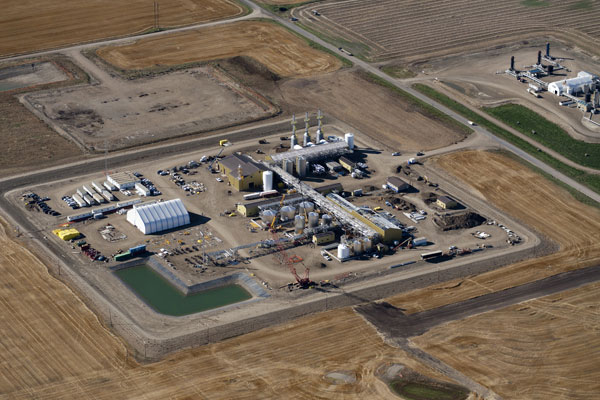
Sask. water officials worry about winter freeze if rivers can’t be cleaned in time
by Rob Drinkwater, The Canadian Press

Communities in Saskatchewan have used above-ground pipes after the Husky oil spill fouled their drinking water, but those won't work in winter months

Husky’s Pikes Peak South oil site in Saskatchewan. PHOTO Husky Energy
Prince Albert city manager Jim Toye said one of the options that’s being discussed is to return to drawing water from the North Saskatchewan River and treating it for hydrocarbons.
“That’s our major plan right now. We do understand that it doesn’t matter what we’re doing here, we have about 95 days before it starts to get really cold in Saskatchewan, that we can’t be above ground with what’s providing our safe, potable water,” Toye said on Sunday.
The city of about 35,000 shut its intakes on the North Saskatchewan shortly after a Husky Energy pipeline spilled up to 250,000 litres of oil mixed with a lighter hydrocarbon called a diluent into the river near Maidstone almost two weeks ago. Since then, it has been relying on stored water in reservoirs as well as from a storm retention pond to supply its treatment plant while it constructed two temporary, above-ground lines along highways to other rivers in the region.
On July 31, the city said a line from the Little Red River was running into its treatment plant and that water was flowing through the system.
Another temporary line about 30 kilometres long that was built to the South Saskatchewan River is pumping water, but the water was not being treated and distributed though city pipes until testing is complete.
Closer to the source of the oil leak, North Battleford is also building a temporary line to the town of Battleford and has been relying on well water since shutting its intakes on the North Saskatchewan.
Duane McKay, Saskatchewan’s commissioner of emergency management, said a planning group has been established to come up with options to supply affected communities with water into winter.
Sam Ferris with the Saskatchewan Water Security Agency said that besides treating water for hydrocarbons, other options include drilling new wells as sources for water.
“I think within days of the initial incident, people were looking at long-term solutions, although the focus primarily was in establishing the emergency connections to water supplies,” Ferris told a phone-in news briefing on Sunday.
Toye said Prince Albert staff recently talked about how to treat water for hydrocarbons when they met with Husky officials several days ago. Options include pre-treatment before it enters its water treament plant, or enhancement of the treatment plant.
“It’s not built to remove hydrocarbons as it is right now,” Toye said about the plant.
He said wells probably woudn’t supply enough water for Prince Albert, which also provides water to other outlying communities.
The province said the cleanup and capture of oil along the affected shorline downstream from the oil spill contines. Close to 50 wildlife deaths have been reported by the province, but a species breakdown was not available.
Husky has said it noticed pressure “anomalies” in part of its pipeline on July 20 and detected the spill the following day, when the line was immediately shut down.
Husky Energy and the province both say the cause of the spill is still under investigation.
The government has said it expects Husky to submit that full report within 90 days of the pipeline breach.